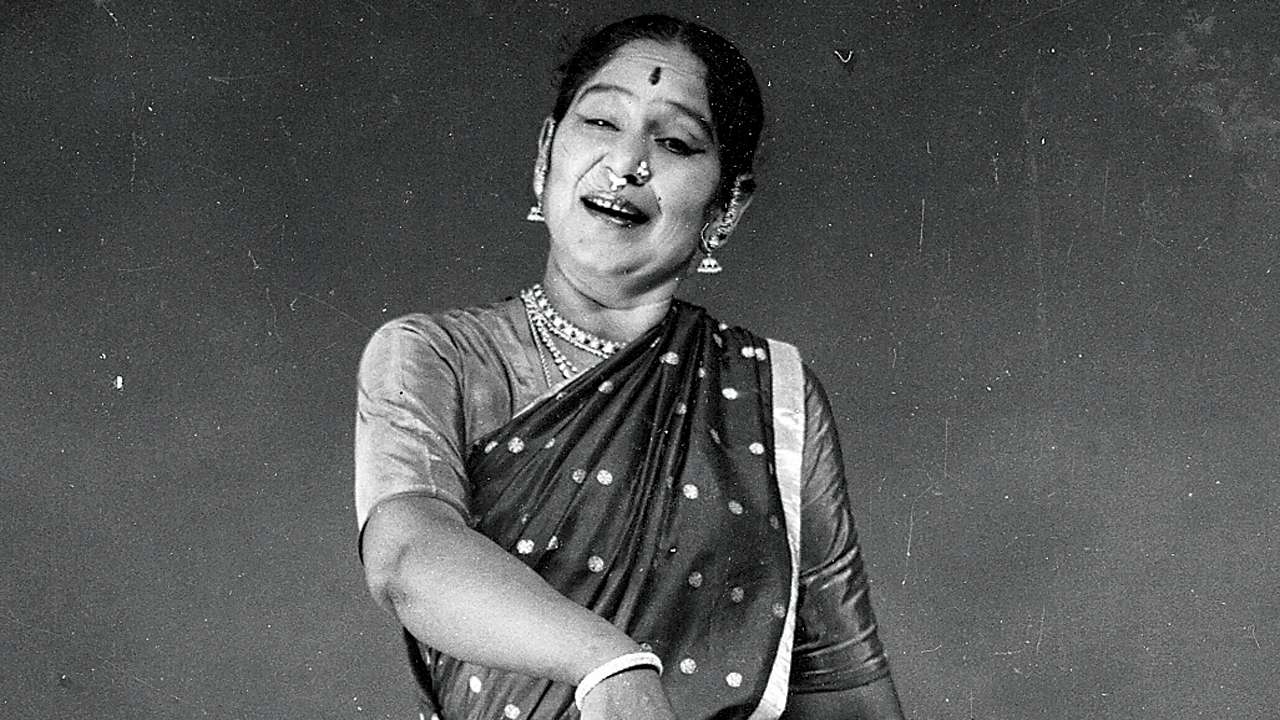
The middle-aged woman in a casual cotton saree, seated on a reed mat in a modest home, is doing abhinaya, showing on her face and with gestures, all the frustrations of a lovelorn maiden. Another woman renders the song tremulously, afraid to intrude upon the dance. The testy dancer chides the singer, “Don’t whisper, sing!” The singer obediently raises her voice, but the dancer is still not satisfied. She launches into a melodic curve with a force of her own, to match the feeling she wishes to evoke, in both the music and dance. Is the singer annoyed? Not at all. Why, she is nodding her head in appreciation!
The dancer was Bala, the renowned Bharatanatyam diva Thanjavur Balasaraswati (1918-1984), the singer was Carnatic musician Kunja, idolised as MS Subbulakshmi. Born into the devadasi community of courtesan artists, these two custodians of their family legacy had been friends from childhood, though they had nothing in common except genius. Timid MS was a conformist. Doughty Bala lived her life on her own terms.
As the annual Chennai music and dance season 2017-18 celebrates Balasaraswati’s centenary with fulsome tributes in overflowing auditoria, I recall that during her own lifetime, Bala’s recitals were confined to a small audience of connoisseurs. If a mere fraction of those who reverently intone her name today had actually attended her performances, the living Bala would have packed the halls! True, acclaim in the West increased that audience, but only marginally. After all, to read that Margot Fonteyn or Martha Graham were inspired by Balasaraswati meant little to Indians who hardly knew these distant stars.
But neither Bala, nor the eight generations of great artists in her family, cared about audience approval. They gloried in their family legacy recorded from the 18th century with Papammal (dancer) and her daughter Rukmini (vocalist) at the Tanjore court. The twin arts were inseparably nourished by successors down to impoverished “Veena” Dhanam, whose name ironically signified wealth. However, she did display dazzling treasures of a more lasting kind, to the cognoscenti who braved the noisome streets of Georgetown in old Madras, to attend Friday music soirees in her home. Asked why their school drew so few listeners, vocalist granddaughter Brinda quipped, “Not everyone can be so lucky!” Flautist grandson Viswanathan added, “After all, a jeweller displays his diamond only to those who know its value.”
Old memories and a few old recordings show Bala as the last Bharatanatyam artist who sang as splendidly as she danced, and the only dancer who has ever received the haughty Madras Music Academy’s award — Sangita Kalanidhi, the coveted “Nobel” of Carnatic musicians.
If you heard Bala sing, you knew just how a mature artist preserves tradition — not as an untouchable museum relic, but by creatively integrating influences without compromising core values. You realised that tradition is not isolation, but intelligent and selective amalgamation. Just as a stream reflects leaves and flowers from overhanging branches, Bala’s voice shimmered with the Hindustani strains she loved, without deviating from its natural, time-worn path.
Bala was an artists’ artist, in whom music and dancing merged into a singular identity. Carnatic musicians came to “hear” her dance recitals. Hindustani musicians were spellbound. Hadn’t purist Ustad Amir Khan seek her out to trade ragas and melodic patterns? They sang for hours together, oblivious of the chattering world outside! Ustad Vilayat Khan cherished the greenest memories of young Bala, dancing as only she could, making the romance of raag Behag float into a Kolkata courtyard.
Writers and visual artists continue to live in their tangible work. But performing artists? They can live on only through inspired disciples. Bala did teach a few Indian and foreign students. However, she often remarked, quite bluntly, that she wanted her art to die with her. Even daughter Lakshmi had to claim her rightful heritage through osmosis. Grandson Aniruddh Knight struggles today to keep the torch burning. Not easy. Not in a world that sees art as brisk entertainment.
Sometimes an outsider comes up with insights. A New York critic noted that Balasaraswati “demonstrates how aesthetic pleasure and ethical instruction can be expressed simultaneously through music, dance and acting”. She added that when Bala drew her heroes, villains, sinners and saints from Hindu legends, when she embodied the faithful crying out to be saved, she was really creating metaphors. We who saw her in India also believed that Bala shaped universal myths. Why? To unravel the riddle of existence, to link the self to something beyond what is known. And this quest cannot die. We don’t have to be musicians or dancers, but just human, to keep it alive, to seek that goal.
The author is a playwright, theatre director, musician and journalist